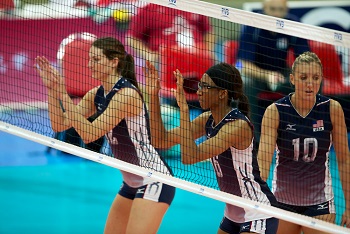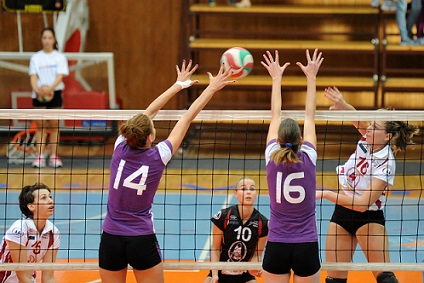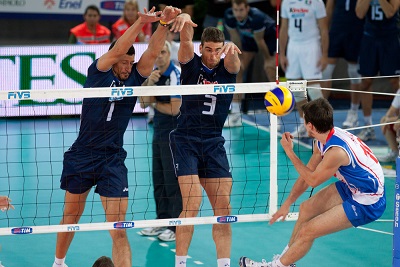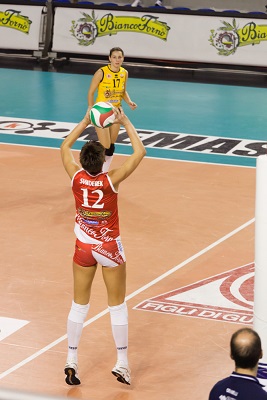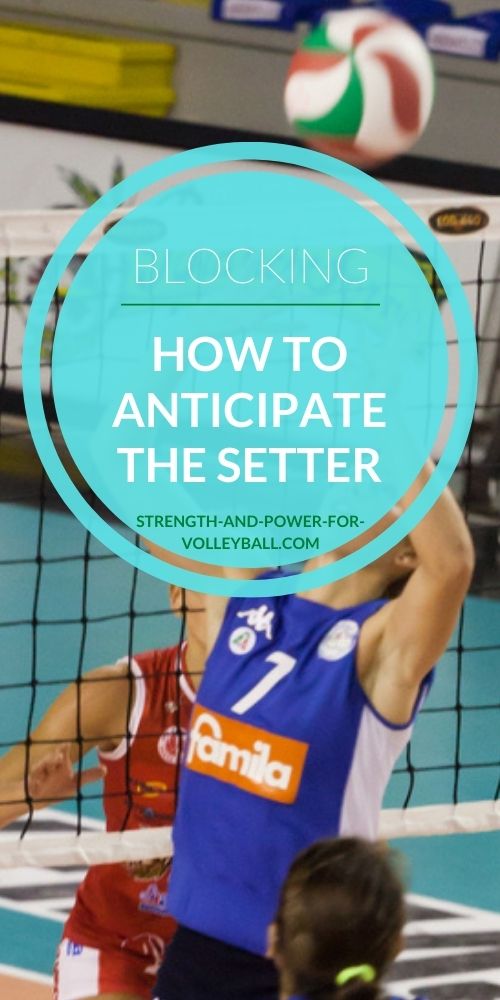Blocking in Volleyball
For blocking in volleyball, let's first consider what the skill of blocking consists of. Blocking is a movement combining the hands, feet, and arms.
4 Types of Sets to Anticipate
A blocker needs to understand that the hitter is likely going to hit where the set takes them.
Prepare for these 4 types of situations...
1)Inside set,
2)Outside set,
3)Tip Situation, and
4)Set Off the net.
As a blocker, if you are able to recognize these sets, you'll be better prepared to block.
For example, when the set is more inside, the hitter is more likely to hit crosscourt angle.
If the set is pushed way outside, the hitter tends to hit more down the line.
If the hitter is in trouble, watch out for the tip.
A ball set off the net will be attacked differently than a ball set tight. For example, a hard hit ball coming from off the net will go deeper.
As a blocker, you need to "see" and recognize these possible situations.
The better a blocker is at reading the play, the more efficient the team can respond and attack.
Preparing to Block
Just like with other skills in volleyball, the better you can anticipate what is going to happen, the easier it is to make a successful play.
To prepare to block...
1. Call out the hitters. For example, #6 outside, #3 middle, and #5 opposite. Know who the hitters are before the serve.
2. Call out the setter. Is the setter front row or back row? It's important to know
if the setter is front row because if she is, you may have to help out with blocking her.
Scan the court and find the front row attackers.
Identify the setter (front or back).
Penetrating the Net
If you want to be successful blocking in volleyball, you better learn to penetrate above the net into the opponents space. Penetrating the net is considered the most important part to blocking in volleyball. You want to "seal the area" over the net.
Important tips for hand position...
1. Block with hands, not arms.
2. Many blocks should occur by making contact with just one hand.
3. Block with the big part of your hands... thumbs up and fingers out.
Block with hands, not arms.
Get hands on the ball and you're less likely to get tooled.
Good Penetration with Hands on the Ball
"Front the Hitter"
Most people will hit the ball the direction it takes them.
"Front the Hitter" means get in front of the hitter the direction the hitter is facing.
The blocker could focus on lining up with the "outside hand" on the ball.
Give and Takeaway Shots
Blocker's need to be skilled at giving and taking away shots.
For example, if a player is known to have a great line hit, the blocker can takeaway line.
Every team needs to have a block and defense strategy.
Keys to an effective strategy...
1. If the strategy is to block line, don't show it early.
2. Wait and block line late. You don't want to give away your team strategy.
If you wait and show the block late, your opponent will often make a mistake and play right into your hands.
Having a strategy for blocking in volleyball doesn't guarantee you'll win, but it can help your team by having a plan of what to do.
Defending an Attack Down the Line
Read and Anticipate the Opponent
It's very important to keep your eyes on the setter.
If you learn to "key in" on the setter, you'll learn to get a head start on what the setter is going to do.
Most setter's have "setting technique" that's consistent.
For example, many setters take the ball more out in front of their body when they set outside vs setting back.
Watching for cues like these will help you get a read on where the ball will be set. This is important because the better you are at reading the setter, the easier blocking in volleyball.
Read and Anticipate the Setter
Tips for Middle Blocking in Volleyball
First thing a middle blocker should do is watch where the ball is passed.
You want to read and track the flight of the ball.
Next, find the middle hitter.
Your #1 responsibility as a middle blocker is to find the middle hitter and know what they are doing.
Once you have identified what play the middle is likely running, look at the setter and try to figure out what they are doing.
For clues, watch the setter's hands. Look at hand position and where the ball is going to contact the hands. If the setter is positioned more behind the ball, look for an outside set. If the position is more neutral, watch for middle or back. If the setter drops an arm, watch for the dump.
This all happens really fast. You don't want tunnel vision. You want be able to see both the hitter and setter. Watch, anticipate, and react.
Once the ball has left the setters hands, you don't need to watch the ball anymore.
The hitter goes where the ball goes. Recognize where the ball is set and watch the hitter.
1) Watch the pass.
2) Watch where the ball goes.
3) Find the setter.
4) Find the middle and figure out what pattern they are running.
5) Find the setter again.
6) After the ball is released from the setter find the hitter.
If you enjoyed these tips and would like to keep it close to you at any time, just save this pin to your Pinterest Volleyball Training Board.
Volleyball › How to Play Volleyball › Blocking Tips
